Team Dynamics Analysis: UNICEF Fundraising Event and Peer Review
VerifiedAdded on 2020/05/16
|9
|2771
|207
Report
AI Summary
This report provides an analysis of team dynamics within the context of a UNICEF fundraising event. It examines the psychological and unconscious forces influencing team behavior and performance, drawing on concepts like trust, conflict resolution, accountability, commitment, and results, as highlighted by Patrick Lencioni. The report details the team's composition, activities, and outcomes, including the diverse backgrounds of team members and the role of effective leadership in fostering collaboration and self-management. It incorporates a peer review of team member contributions and assesses the team's development stages based on Tuckman's model (forming, storming, norming, and performing). The analysis reflects on the challenges faced, such as initial conflicts and skepticism, and how they were overcome to achieve the fundraising goals, emphasizing the importance of equity, effective communication, and the leader's role in guiding the team through various stages of development. The report underscores the significance of teamwork, self-reflection, and the application of theoretical models in achieving collective objectives.
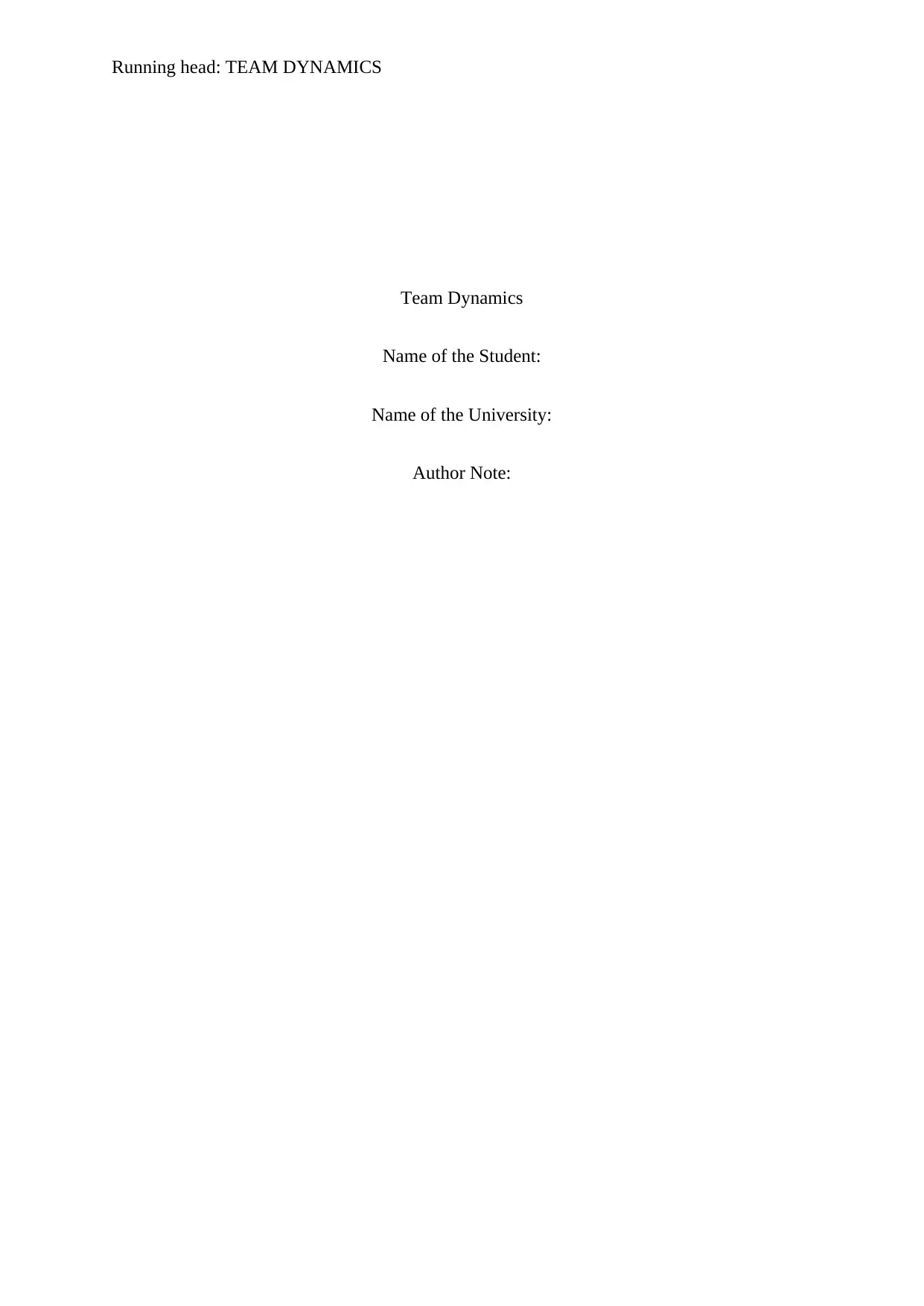
Running head: TEAM DYNAMICS
Team Dynamics
Name of the Student:
Name of the University:
Author Note:
Team Dynamics
Name of the Student:
Name of the University:
Author Note:
Paraphrase This Document
Need a fresh take? Get an instant paraphrase of this document with our AI Paraphraser
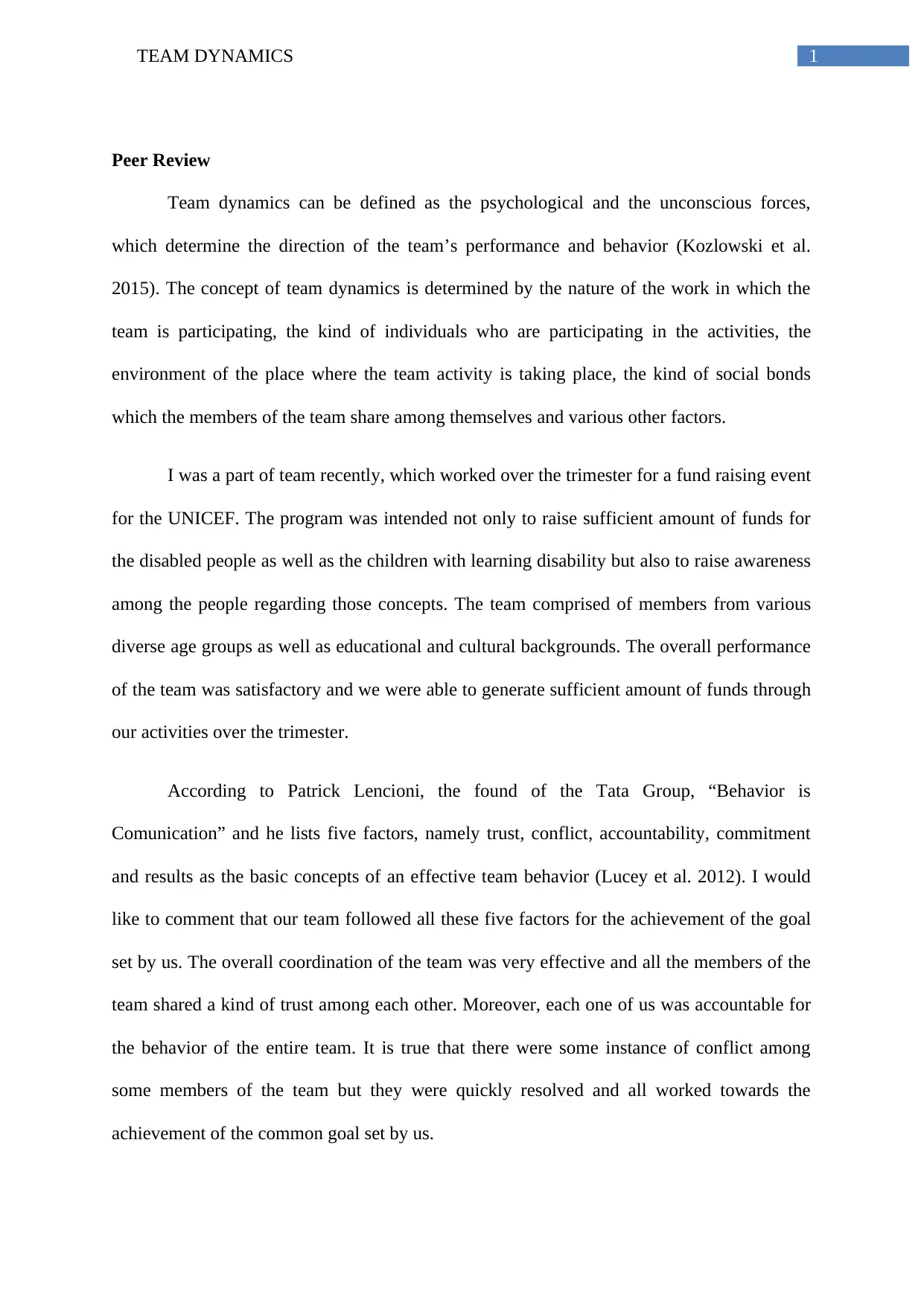
1TEAM DYNAMICS
Peer Review
Team dynamics can be defined as the psychological and the unconscious forces,
which determine the direction of the team’s performance and behavior (Kozlowski et al.
2015). The concept of team dynamics is determined by the nature of the work in which the
team is participating, the kind of individuals who are participating in the activities, the
environment of the place where the team activity is taking place, the kind of social bonds
which the members of the team share among themselves and various other factors.
I was a part of team recently, which worked over the trimester for a fund raising event
for the UNICEF. The program was intended not only to raise sufficient amount of funds for
the disabled people as well as the children with learning disability but also to raise awareness
among the people regarding those concepts. The team comprised of members from various
diverse age groups as well as educational and cultural backgrounds. The overall performance
of the team was satisfactory and we were able to generate sufficient amount of funds through
our activities over the trimester.
According to Patrick Lencioni, the found of the Tata Group, “Behavior is
Comunication” and he lists five factors, namely trust, conflict, accountability, commitment
and results as the basic concepts of an effective team behavior (Lucey et al. 2012). I would
like to comment that our team followed all these five factors for the achievement of the goal
set by us. The overall coordination of the team was very effective and all the members of the
team shared a kind of trust among each other. Moreover, each one of us was accountable for
the behavior of the entire team. It is true that there were some instance of conflict among
some members of the team but they were quickly resolved and all worked towards the
achievement of the common goal set by us.
Peer Review
Team dynamics can be defined as the psychological and the unconscious forces,
which determine the direction of the team’s performance and behavior (Kozlowski et al.
2015). The concept of team dynamics is determined by the nature of the work in which the
team is participating, the kind of individuals who are participating in the activities, the
environment of the place where the team activity is taking place, the kind of social bonds
which the members of the team share among themselves and various other factors.
I was a part of team recently, which worked over the trimester for a fund raising event
for the UNICEF. The program was intended not only to raise sufficient amount of funds for
the disabled people as well as the children with learning disability but also to raise awareness
among the people regarding those concepts. The team comprised of members from various
diverse age groups as well as educational and cultural backgrounds. The overall performance
of the team was satisfactory and we were able to generate sufficient amount of funds through
our activities over the trimester.
According to Patrick Lencioni, the found of the Tata Group, “Behavior is
Comunication” and he lists five factors, namely trust, conflict, accountability, commitment
and results as the basic concepts of an effective team behavior (Lucey et al. 2012). I would
like to comment that our team followed all these five factors for the achievement of the goal
set by us. The overall coordination of the team was very effective and all the members of the
team shared a kind of trust among each other. Moreover, each one of us was accountable for
the behavior of the entire team. It is true that there were some instance of conflict among
some members of the team but they were quickly resolved and all worked towards the
achievement of the common goal set by us.
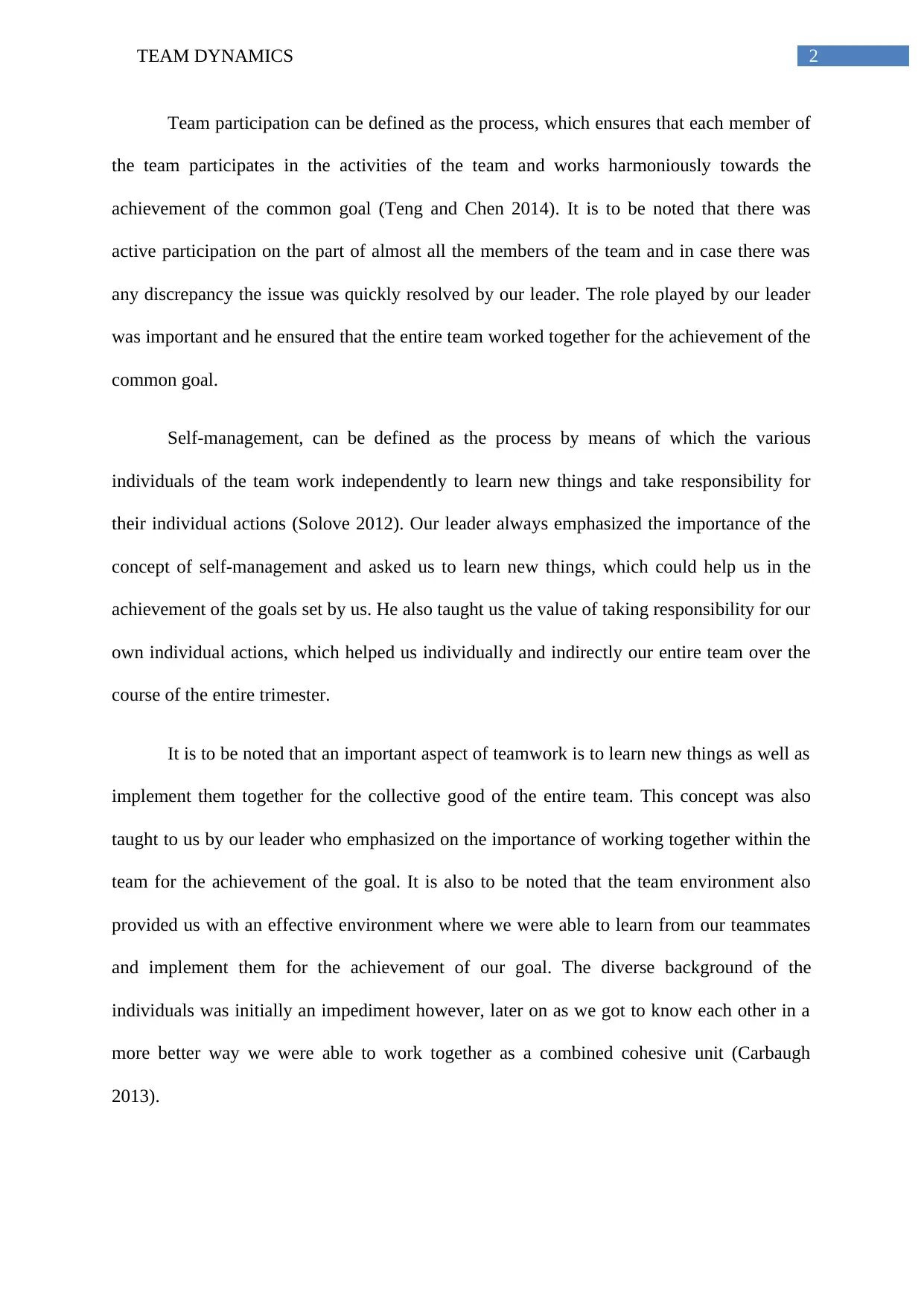
2TEAM DYNAMICS
Team participation can be defined as the process, which ensures that each member of
the team participates in the activities of the team and works harmoniously towards the
achievement of the common goal (Teng and Chen 2014). It is to be noted that there was
active participation on the part of almost all the members of the team and in case there was
any discrepancy the issue was quickly resolved by our leader. The role played by our leader
was important and he ensured that the entire team worked together for the achievement of the
common goal.
Self-management, can be defined as the process by means of which the various
individuals of the team work independently to learn new things and take responsibility for
their individual actions (Solove 2012). Our leader always emphasized the importance of the
concept of self-management and asked us to learn new things, which could help us in the
achievement of the goals set by us. He also taught us the value of taking responsibility for our
own individual actions, which helped us individually and indirectly our entire team over the
course of the entire trimester.
It is to be noted that an important aspect of teamwork is to learn new things as well as
implement them together for the collective good of the entire team. This concept was also
taught to us by our leader who emphasized on the importance of working together within the
team for the achievement of the goal. It is also to be noted that the team environment also
provided us with an effective environment where we were able to learn from our teammates
and implement them for the achievement of our goal. The diverse background of the
individuals was initially an impediment however, later on as we got to know each other in a
more better way we were able to work together as a combined cohesive unit (Carbaugh
2013).
Team participation can be defined as the process, which ensures that each member of
the team participates in the activities of the team and works harmoniously towards the
achievement of the common goal (Teng and Chen 2014). It is to be noted that there was
active participation on the part of almost all the members of the team and in case there was
any discrepancy the issue was quickly resolved by our leader. The role played by our leader
was important and he ensured that the entire team worked together for the achievement of the
common goal.
Self-management, can be defined as the process by means of which the various
individuals of the team work independently to learn new things and take responsibility for
their individual actions (Solove 2012). Our leader always emphasized the importance of the
concept of self-management and asked us to learn new things, which could help us in the
achievement of the goals set by us. He also taught us the value of taking responsibility for our
own individual actions, which helped us individually and indirectly our entire team over the
course of the entire trimester.
It is to be noted that an important aspect of teamwork is to learn new things as well as
implement them together for the collective good of the entire team. This concept was also
taught to us by our leader who emphasized on the importance of working together within the
team for the achievement of the goal. It is also to be noted that the team environment also
provided us with an effective environment where we were able to learn from our teammates
and implement them for the achievement of our goal. The diverse background of the
individuals was initially an impediment however, later on as we got to know each other in a
more better way we were able to work together as a combined cohesive unit (Carbaugh
2013).
⊘ This is a preview!⊘
Do you want full access?
Subscribe today to unlock all pages.

Trusted by 1+ million students worldwide
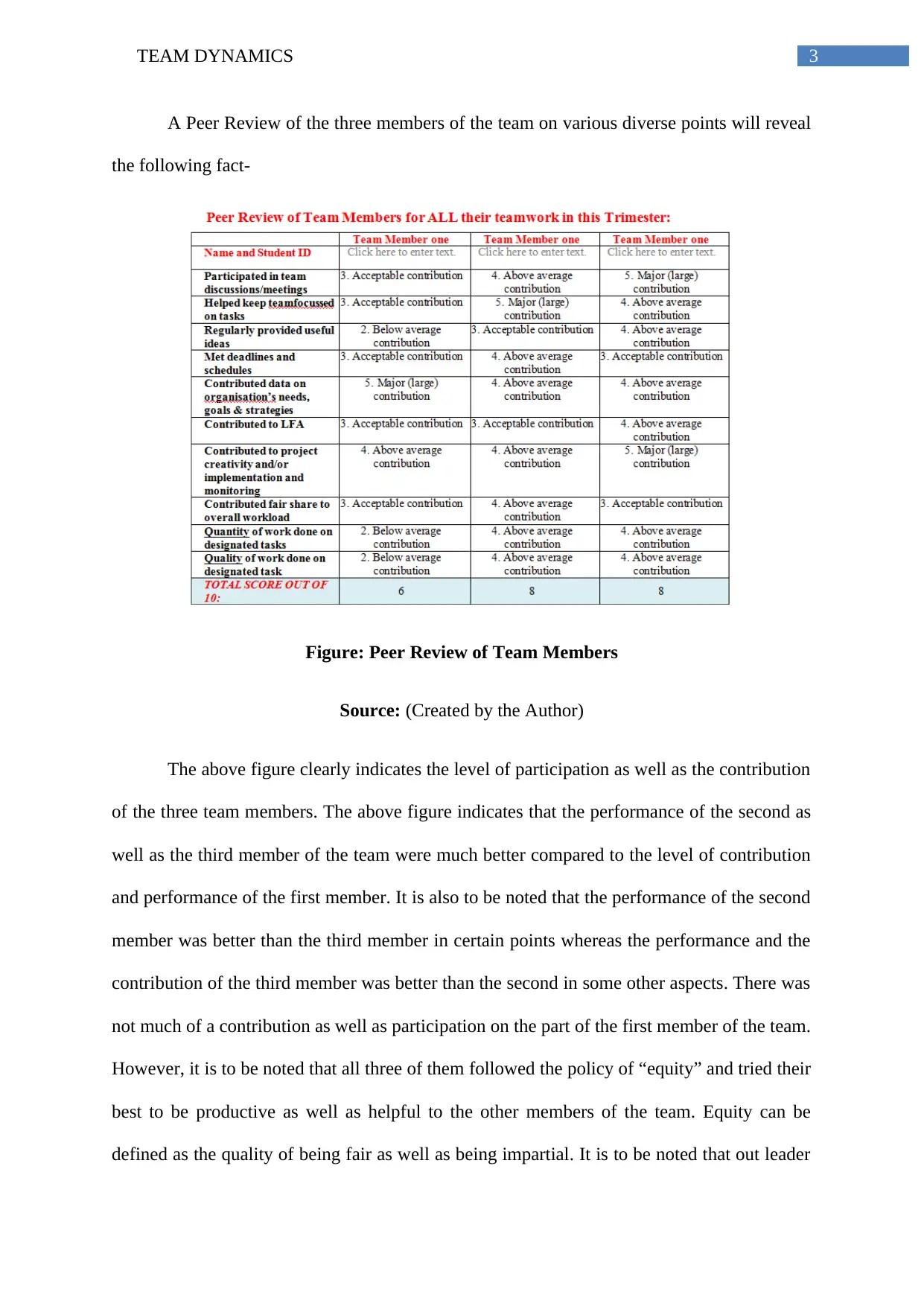
3TEAM DYNAMICS
A Peer Review of the three members of the team on various diverse points will reveal
the following fact-
Figure: Peer Review of Team Members
Source: (Created by the Author)
The above figure clearly indicates the level of participation as well as the contribution
of the three team members. The above figure indicates that the performance of the second as
well as the third member of the team were much better compared to the level of contribution
and performance of the first member. It is also to be noted that the performance of the second
member was better than the third member in certain points whereas the performance and the
contribution of the third member was better than the second in some other aspects. There was
not much of a contribution as well as participation on the part of the first member of the team.
However, it is to be noted that all three of them followed the policy of “equity” and tried their
best to be productive as well as helpful to the other members of the team. Equity can be
defined as the quality of being fair as well as being impartial. It is to be noted that out leader
A Peer Review of the three members of the team on various diverse points will reveal
the following fact-
Figure: Peer Review of Team Members
Source: (Created by the Author)
The above figure clearly indicates the level of participation as well as the contribution
of the three team members. The above figure indicates that the performance of the second as
well as the third member of the team were much better compared to the level of contribution
and performance of the first member. It is also to be noted that the performance of the second
member was better than the third member in certain points whereas the performance and the
contribution of the third member was better than the second in some other aspects. There was
not much of a contribution as well as participation on the part of the first member of the team.
However, it is to be noted that all three of them followed the policy of “equity” and tried their
best to be productive as well as helpful to the other members of the team. Equity can be
defined as the quality of being fair as well as being impartial. It is to be noted that out leader
Paraphrase This Document
Need a fresh take? Get an instant paraphrase of this document with our AI Paraphraser
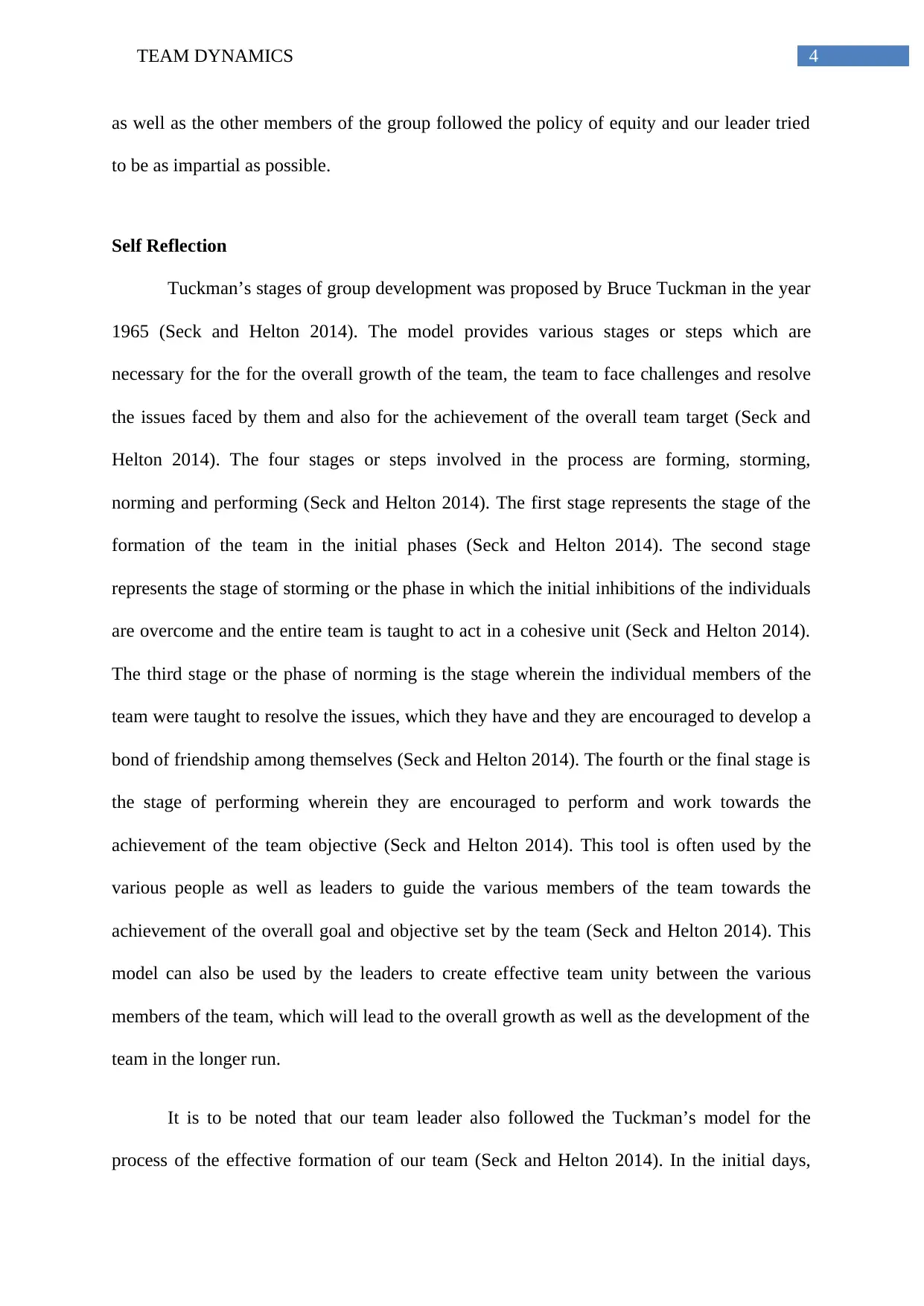
4TEAM DYNAMICS
as well as the other members of the group followed the policy of equity and our leader tried
to be as impartial as possible.
Self Reflection
Tuckman’s stages of group development was proposed by Bruce Tuckman in the year
1965 (Seck and Helton 2014). The model provides various stages or steps which are
necessary for the for the overall growth of the team, the team to face challenges and resolve
the issues faced by them and also for the achievement of the overall team target (Seck and
Helton 2014). The four stages or steps involved in the process are forming, storming,
norming and performing (Seck and Helton 2014). The first stage represents the stage of the
formation of the team in the initial phases (Seck and Helton 2014). The second stage
represents the stage of storming or the phase in which the initial inhibitions of the individuals
are overcome and the entire team is taught to act in a cohesive unit (Seck and Helton 2014).
The third stage or the phase of norming is the stage wherein the individual members of the
team were taught to resolve the issues, which they have and they are encouraged to develop a
bond of friendship among themselves (Seck and Helton 2014). The fourth or the final stage is
the stage of performing wherein they are encouraged to perform and work towards the
achievement of the team objective (Seck and Helton 2014). This tool is often used by the
various people as well as leaders to guide the various members of the team towards the
achievement of the overall goal and objective set by the team (Seck and Helton 2014). This
model can also be used by the leaders to create effective team unity between the various
members of the team, which will lead to the overall growth as well as the development of the
team in the longer run.
It is to be noted that our team leader also followed the Tuckman’s model for the
process of the effective formation of our team (Seck and Helton 2014). In the initial days,
as well as the other members of the group followed the policy of equity and our leader tried
to be as impartial as possible.
Self Reflection
Tuckman’s stages of group development was proposed by Bruce Tuckman in the year
1965 (Seck and Helton 2014). The model provides various stages or steps which are
necessary for the for the overall growth of the team, the team to face challenges and resolve
the issues faced by them and also for the achievement of the overall team target (Seck and
Helton 2014). The four stages or steps involved in the process are forming, storming,
norming and performing (Seck and Helton 2014). The first stage represents the stage of the
formation of the team in the initial phases (Seck and Helton 2014). The second stage
represents the stage of storming or the phase in which the initial inhibitions of the individuals
are overcome and the entire team is taught to act in a cohesive unit (Seck and Helton 2014).
The third stage or the phase of norming is the stage wherein the individual members of the
team were taught to resolve the issues, which they have and they are encouraged to develop a
bond of friendship among themselves (Seck and Helton 2014). The fourth or the final stage is
the stage of performing wherein they are encouraged to perform and work towards the
achievement of the team objective (Seck and Helton 2014). This tool is often used by the
various people as well as leaders to guide the various members of the team towards the
achievement of the overall goal and objective set by the team (Seck and Helton 2014). This
model can also be used by the leaders to create effective team unity between the various
members of the team, which will lead to the overall growth as well as the development of the
team in the longer run.
It is to be noted that our team leader also followed the Tuckman’s model for the
process of the effective formation of our team (Seck and Helton 2014). In the initial days,
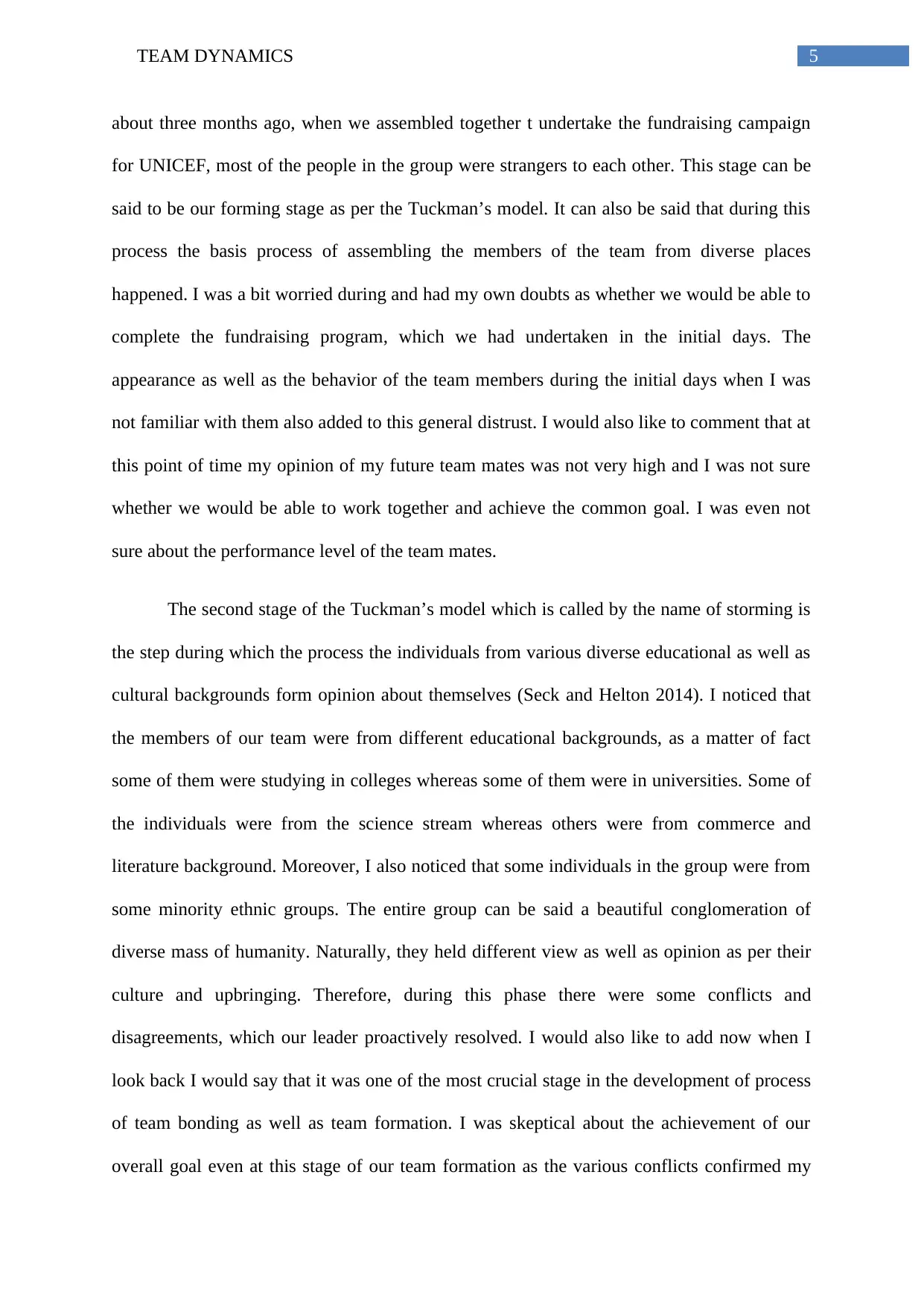
5TEAM DYNAMICS
about three months ago, when we assembled together t undertake the fundraising campaign
for UNICEF, most of the people in the group were strangers to each other. This stage can be
said to be our forming stage as per the Tuckman’s model. It can also be said that during this
process the basis process of assembling the members of the team from diverse places
happened. I was a bit worried during and had my own doubts as whether we would be able to
complete the fundraising program, which we had undertaken in the initial days. The
appearance as well as the behavior of the team members during the initial days when I was
not familiar with them also added to this general distrust. I would also like to comment that at
this point of time my opinion of my future team mates was not very high and I was not sure
whether we would be able to work together and achieve the common goal. I was even not
sure about the performance level of the team mates.
The second stage of the Tuckman’s model which is called by the name of storming is
the step during which the process the individuals from various diverse educational as well as
cultural backgrounds form opinion about themselves (Seck and Helton 2014). I noticed that
the members of our team were from different educational backgrounds, as a matter of fact
some of them were studying in colleges whereas some of them were in universities. Some of
the individuals were from the science stream whereas others were from commerce and
literature background. Moreover, I also noticed that some individuals in the group were from
some minority ethnic groups. The entire group can be said a beautiful conglomeration of
diverse mass of humanity. Naturally, they held different view as well as opinion as per their
culture and upbringing. Therefore, during this phase there were some conflicts and
disagreements, which our leader proactively resolved. I would also like to add now when I
look back I would say that it was one of the most crucial stage in the development of process
of team bonding as well as team formation. I was skeptical about the achievement of our
overall goal even at this stage of our team formation as the various conflicts confirmed my
about three months ago, when we assembled together t undertake the fundraising campaign
for UNICEF, most of the people in the group were strangers to each other. This stage can be
said to be our forming stage as per the Tuckman’s model. It can also be said that during this
process the basis process of assembling the members of the team from diverse places
happened. I was a bit worried during and had my own doubts as whether we would be able to
complete the fundraising program, which we had undertaken in the initial days. The
appearance as well as the behavior of the team members during the initial days when I was
not familiar with them also added to this general distrust. I would also like to comment that at
this point of time my opinion of my future team mates was not very high and I was not sure
whether we would be able to work together and achieve the common goal. I was even not
sure about the performance level of the team mates.
The second stage of the Tuckman’s model which is called by the name of storming is
the step during which the process the individuals from various diverse educational as well as
cultural backgrounds form opinion about themselves (Seck and Helton 2014). I noticed that
the members of our team were from different educational backgrounds, as a matter of fact
some of them were studying in colleges whereas some of them were in universities. Some of
the individuals were from the science stream whereas others were from commerce and
literature background. Moreover, I also noticed that some individuals in the group were from
some minority ethnic groups. The entire group can be said a beautiful conglomeration of
diverse mass of humanity. Naturally, they held different view as well as opinion as per their
culture and upbringing. Therefore, during this phase there were some conflicts and
disagreements, which our leader proactively resolved. I would also like to add now when I
look back I would say that it was one of the most crucial stage in the development of process
of team bonding as well as team formation. I was skeptical about the achievement of our
overall goal even at this stage of our team formation as the various conflicts confirmed my
⊘ This is a preview!⊘
Do you want full access?
Subscribe today to unlock all pages.

Trusted by 1+ million students worldwide
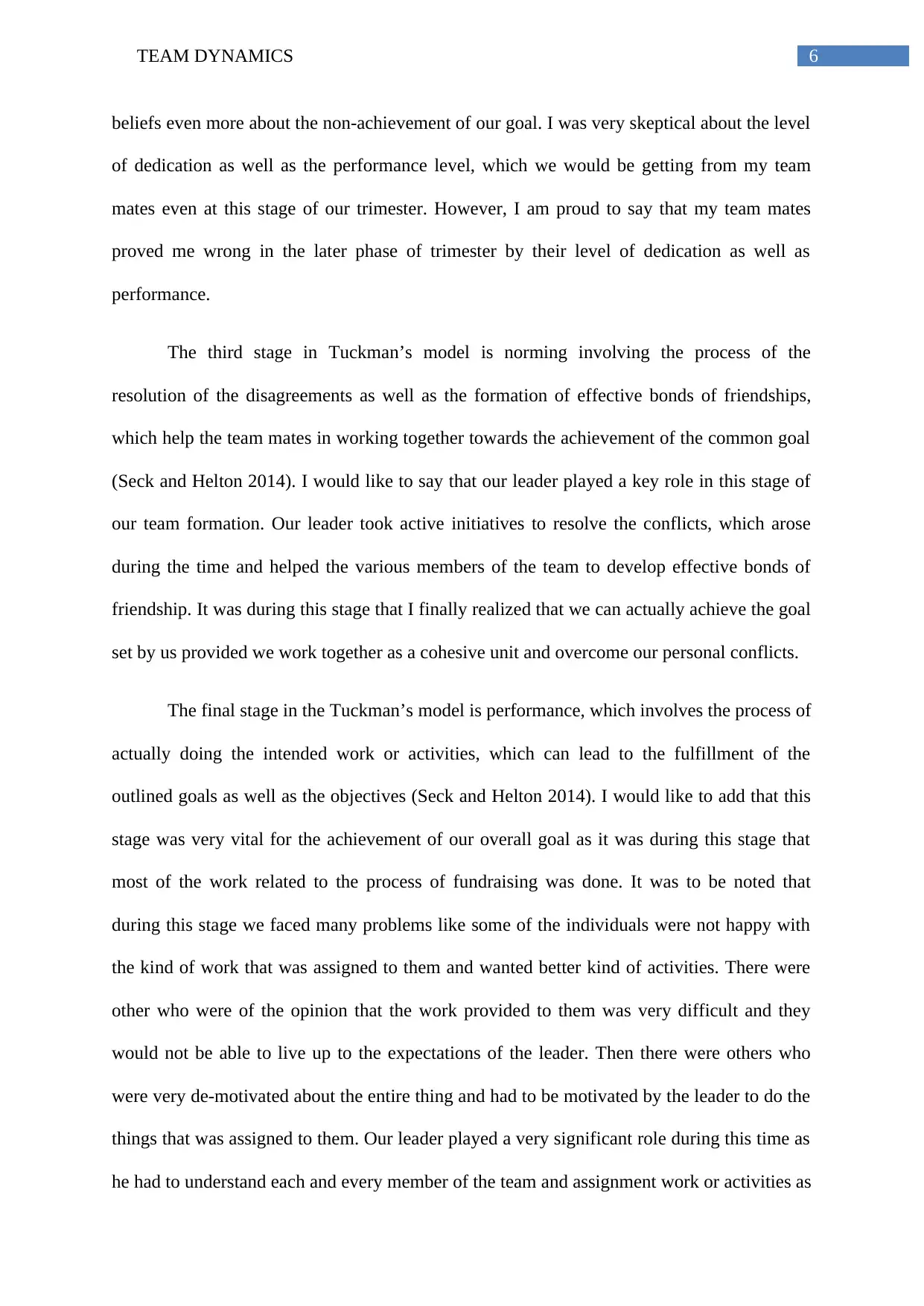
6TEAM DYNAMICS
beliefs even more about the non-achievement of our goal. I was very skeptical about the level
of dedication as well as the performance level, which we would be getting from my team
mates even at this stage of our trimester. However, I am proud to say that my team mates
proved me wrong in the later phase of trimester by their level of dedication as well as
performance.
The third stage in Tuckman’s model is norming involving the process of the
resolution of the disagreements as well as the formation of effective bonds of friendships,
which help the team mates in working together towards the achievement of the common goal
(Seck and Helton 2014). I would like to say that our leader played a key role in this stage of
our team formation. Our leader took active initiatives to resolve the conflicts, which arose
during the time and helped the various members of the team to develop effective bonds of
friendship. It was during this stage that I finally realized that we can actually achieve the goal
set by us provided we work together as a cohesive unit and overcome our personal conflicts.
The final stage in the Tuckman’s model is performance, which involves the process of
actually doing the intended work or activities, which can lead to the fulfillment of the
outlined goals as well as the objectives (Seck and Helton 2014). I would like to add that this
stage was very vital for the achievement of our overall goal as it was during this stage that
most of the work related to the process of fundraising was done. It was to be noted that
during this stage we faced many problems like some of the individuals were not happy with
the kind of work that was assigned to them and wanted better kind of activities. There were
other who were of the opinion that the work provided to them was very difficult and they
would not be able to live up to the expectations of the leader. Then there were others who
were very de-motivated about the entire thing and had to be motivated by the leader to do the
things that was assigned to them. Our leader played a very significant role during this time as
he had to understand each and every member of the team and assignment work or activities as
beliefs even more about the non-achievement of our goal. I was very skeptical about the level
of dedication as well as the performance level, which we would be getting from my team
mates even at this stage of our trimester. However, I am proud to say that my team mates
proved me wrong in the later phase of trimester by their level of dedication as well as
performance.
The third stage in Tuckman’s model is norming involving the process of the
resolution of the disagreements as well as the formation of effective bonds of friendships,
which help the team mates in working together towards the achievement of the common goal
(Seck and Helton 2014). I would like to say that our leader played a key role in this stage of
our team formation. Our leader took active initiatives to resolve the conflicts, which arose
during the time and helped the various members of the team to develop effective bonds of
friendship. It was during this stage that I finally realized that we can actually achieve the goal
set by us provided we work together as a cohesive unit and overcome our personal conflicts.
The final stage in the Tuckman’s model is performance, which involves the process of
actually doing the intended work or activities, which can lead to the fulfillment of the
outlined goals as well as the objectives (Seck and Helton 2014). I would like to add that this
stage was very vital for the achievement of our overall goal as it was during this stage that
most of the work related to the process of fundraising was done. It was to be noted that
during this stage we faced many problems like some of the individuals were not happy with
the kind of work that was assigned to them and wanted better kind of activities. There were
other who were of the opinion that the work provided to them was very difficult and they
would not be able to live up to the expectations of the leader. Then there were others who
were very de-motivated about the entire thing and had to be motivated by the leader to do the
things that was assigned to them. Our leader played a very significant role during this time as
he had to understand each and every member of the team and assignment work or activities as
Paraphrase This Document
Need a fresh take? Get an instant paraphrase of this document with our AI Paraphraser
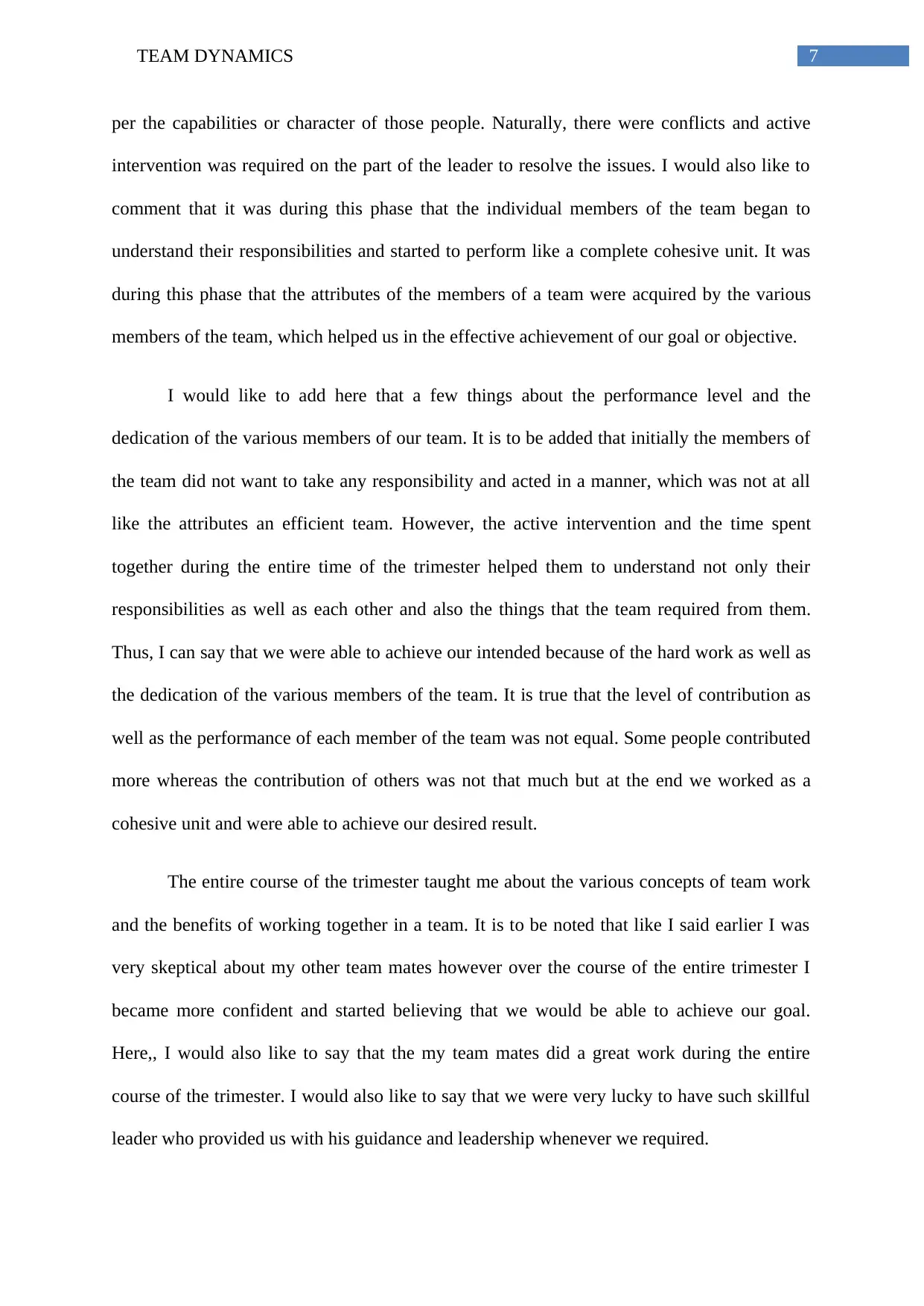
7TEAM DYNAMICS
per the capabilities or character of those people. Naturally, there were conflicts and active
intervention was required on the part of the leader to resolve the issues. I would also like to
comment that it was during this phase that the individual members of the team began to
understand their responsibilities and started to perform like a complete cohesive unit. It was
during this phase that the attributes of the members of a team were acquired by the various
members of the team, which helped us in the effective achievement of our goal or objective.
I would like to add here that a few things about the performance level and the
dedication of the various members of our team. It is to be added that initially the members of
the team did not want to take any responsibility and acted in a manner, which was not at all
like the attributes an efficient team. However, the active intervention and the time spent
together during the entire time of the trimester helped them to understand not only their
responsibilities as well as each other and also the things that the team required from them.
Thus, I can say that we were able to achieve our intended because of the hard work as well as
the dedication of the various members of the team. It is true that the level of contribution as
well as the performance of each member of the team was not equal. Some people contributed
more whereas the contribution of others was not that much but at the end we worked as a
cohesive unit and were able to achieve our desired result.
The entire course of the trimester taught me about the various concepts of team work
and the benefits of working together in a team. It is to be noted that like I said earlier I was
very skeptical about my other team mates however over the course of the entire trimester I
became more confident and started believing that we would be able to achieve our goal.
Here,, I would also like to say that the my team mates did a great work during the entire
course of the trimester. I would also like to say that we were very lucky to have such skillful
leader who provided us with his guidance and leadership whenever we required.
per the capabilities or character of those people. Naturally, there were conflicts and active
intervention was required on the part of the leader to resolve the issues. I would also like to
comment that it was during this phase that the individual members of the team began to
understand their responsibilities and started to perform like a complete cohesive unit. It was
during this phase that the attributes of the members of a team were acquired by the various
members of the team, which helped us in the effective achievement of our goal or objective.
I would like to add here that a few things about the performance level and the
dedication of the various members of our team. It is to be added that initially the members of
the team did not want to take any responsibility and acted in a manner, which was not at all
like the attributes an efficient team. However, the active intervention and the time spent
together during the entire time of the trimester helped them to understand not only their
responsibilities as well as each other and also the things that the team required from them.
Thus, I can say that we were able to achieve our intended because of the hard work as well as
the dedication of the various members of the team. It is true that the level of contribution as
well as the performance of each member of the team was not equal. Some people contributed
more whereas the contribution of others was not that much but at the end we worked as a
cohesive unit and were able to achieve our desired result.
The entire course of the trimester taught me about the various concepts of team work
and the benefits of working together in a team. It is to be noted that like I said earlier I was
very skeptical about my other team mates however over the course of the entire trimester I
became more confident and started believing that we would be able to achieve our goal.
Here,, I would also like to say that the my team mates did a great work during the entire
course of the trimester. I would also like to say that we were very lucky to have such skillful
leader who provided us with his guidance and leadership whenever we required.
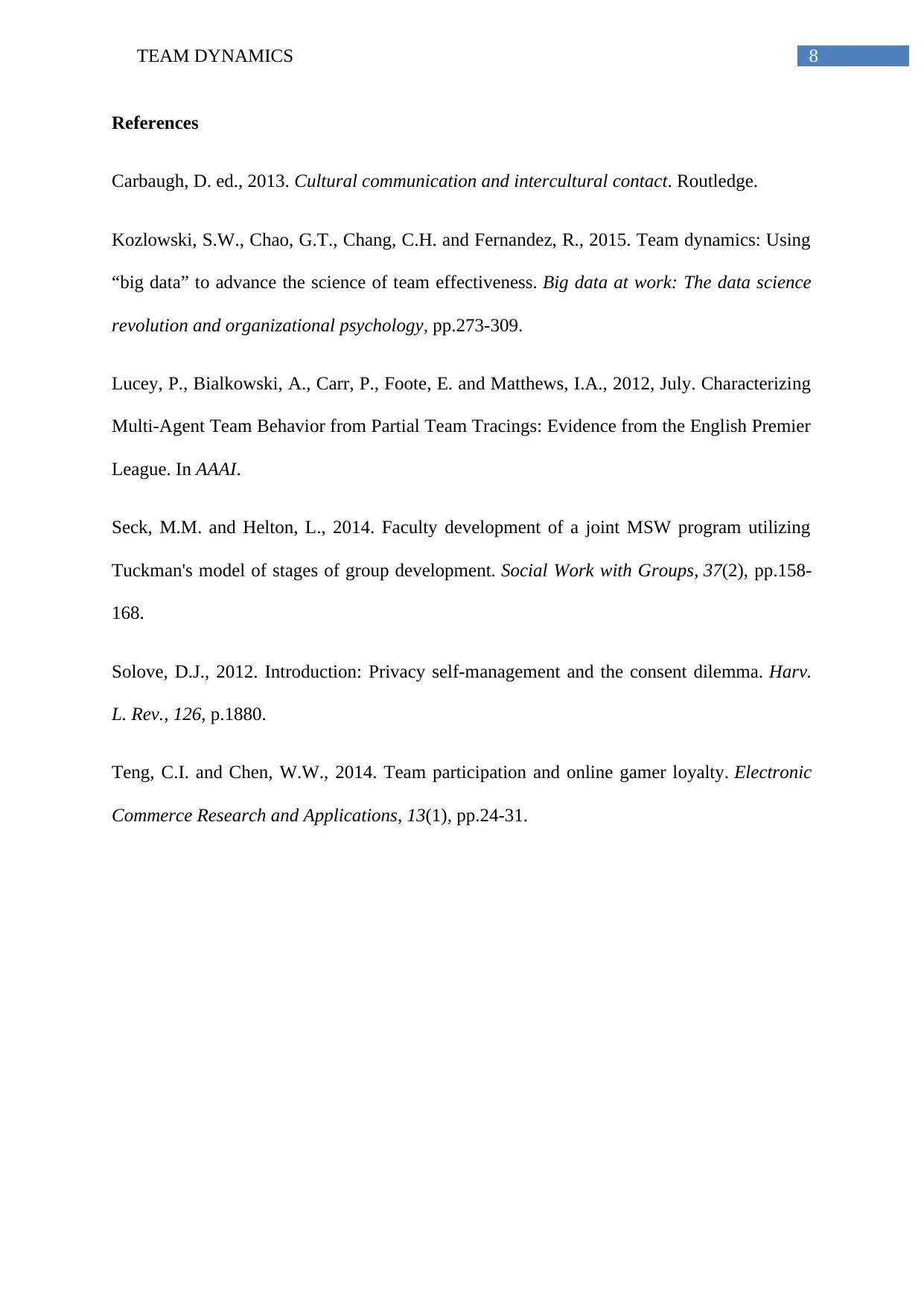
8TEAM DYNAMICS
References
Carbaugh, D. ed., 2013. Cultural communication and intercultural contact. Routledge.
Kozlowski, S.W., Chao, G.T., Chang, C.H. and Fernandez, R., 2015. Team dynamics: Using
“big data” to advance the science of team effectiveness. Big data at work: The data science
revolution and organizational psychology, pp.273-309.
Lucey, P., Bialkowski, A., Carr, P., Foote, E. and Matthews, I.A., 2012, July. Characterizing
Multi-Agent Team Behavior from Partial Team Tracings: Evidence from the English Premier
League. In AAAI.
Seck, M.M. and Helton, L., 2014. Faculty development of a joint MSW program utilizing
Tuckman's model of stages of group development. Social Work with Groups, 37(2), pp.158-
168.
Solove, D.J., 2012. Introduction: Privacy self-management and the consent dilemma. Harv.
L. Rev., 126, p.1880.
Teng, C.I. and Chen, W.W., 2014. Team participation and online gamer loyalty. Electronic
Commerce Research and Applications, 13(1), pp.24-31.
References
Carbaugh, D. ed., 2013. Cultural communication and intercultural contact. Routledge.
Kozlowski, S.W., Chao, G.T., Chang, C.H. and Fernandez, R., 2015. Team dynamics: Using
“big data” to advance the science of team effectiveness. Big data at work: The data science
revolution and organizational psychology, pp.273-309.
Lucey, P., Bialkowski, A., Carr, P., Foote, E. and Matthews, I.A., 2012, July. Characterizing
Multi-Agent Team Behavior from Partial Team Tracings: Evidence from the English Premier
League. In AAAI.
Seck, M.M. and Helton, L., 2014. Faculty development of a joint MSW program utilizing
Tuckman's model of stages of group development. Social Work with Groups, 37(2), pp.158-
168.
Solove, D.J., 2012. Introduction: Privacy self-management and the consent dilemma. Harv.
L. Rev., 126, p.1880.
Teng, C.I. and Chen, W.W., 2014. Team participation and online gamer loyalty. Electronic
Commerce Research and Applications, 13(1), pp.24-31.
⊘ This is a preview!⊘
Do you want full access?
Subscribe today to unlock all pages.

Trusted by 1+ million students worldwide
1 out of 9
Related Documents
Your All-in-One AI-Powered Toolkit for Academic Success.
+13062052269
info@desklib.com
Available 24*7 on WhatsApp / Email
![[object Object]](/_next/static/media/star-bottom.7253800d.svg)
Unlock your academic potential
Copyright © 2020–2025 A2Z Services. All Rights Reserved. Developed and managed by ZUCOL.




